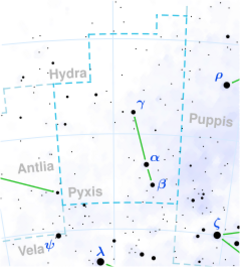Astronomy:Kappa Pyxidis
| Observation data Equinox J2000.0]] (ICRS) | |
|---|---|
| Constellation | Pyxis |
| Right ascension | 09h 08m 02.88015s[1] |
| Declination | –25° 51′ 30.7331″[1] |
| Apparent magnitude (V) | 4.62[2] |
| Characteristics | |
| Spectral type | K4III[3] |
| U−B color index | +1.87[4] |
| B−V color index | +1.594±0.004[2] |
| Astrometry | |
| Radial velocity (Rv) | −44.7±2.8[5] km/s |
| Proper motion (μ) | RA: +34.771[1] mas/yr Dec.: +0.009[1] mas/yr |
| Parallax (π) | 6.3116 ± 0.2408[1] mas |
| Distance | 520 ± 20 ly (158 ± 6 pc) |
| Absolute magnitude (MV) | −1.53[2] |
| Details | |
| Radius | 66.70+0.34 −2.34[1] R☉ |
| Luminosity | 927±40[1] L☉ |
| Surface gravity (log g) | 1.44±0.22[6] cgs |
| Temperature | 3,931±31[6] K |
| Metallicity [Fe/H] | −0.22±0.08[6] dex |
| Other designations | |
| Database references | |
| SIMBAD | data |
Kappa Pyxidis, Latinized from κ Pyxidis, is a single,[8] orange-hued star in the southern constellation of Pyxis. It is visible to the naked eye as a faint point of light with an apparent visual magnitude of +4.62.[2] The star is located approximately 520 light years from the Sun based on parallax, but is drifting closer with a radial velocity of −45 km/s[5] and may come as close as 308 light-years in around 2.6 million years. It is moving through space at the rate of 53.7 km/s relative to the Sun and is following an orbit through the Milky Way galaxy with a large eccentricity of 0.68[2]
This is an aging giant with a stellar classification of K4III,[3] having exhausted the supply of hydrogen at its core then expanded and cooled. At present it has 67[1] times the radius of the Sun. It is a variable star of uncertain type, changing brightness with an amplitude of 0.0058 in visual magnitude over a period of 8.5 days.[9] The star radiates 927 times the luminosity of the Sun from its bloated photosphere at an effective temperature of 3,931 K.[6] A magnitude 10 visual companion is located at an angular separation of 2.1 arcseconds.[10]
References
- ↑ 1.0 1.1 1.2 1.3 1.4 1.5 1.6 1.7 Brown, A. G. A. (August 2018). "Gaia Data Release 2: Summary of the contents and survey properties". Astronomy & Astrophysics 616: A1. doi:10.1051/0004-6361/201833051. Bibcode: 2018A&A...616A...1G. Gaia DR2 record for this source at VizieR.
- ↑ 2.0 2.1 2.2 2.3 2.4 Anderson, E.; Francis, Ch. (2012), "XHIP: An extended hipparcos compilation", Astronomy Letters 38 (5): 331, doi:10.1134/S1063773712050015, Bibcode: 2012AstL...38..331A.
- ↑ 3.0 3.1 Keenan, Philip C.; McNeil, Raymond C. (1989), "The Perkins Catalog of Revised MK Types for the Cooler Stars", The Astrophysical Journal Supplement Series 71: 245, doi:10.1086/191373, Bibcode: 1989ApJS...71..245K.
- ↑ Johnson, H. L. et al. (1966), "UBVRIJKL photometry of the bright stars", Communications of the Lunar and Planetary Laboratory 4 (99): 99, Bibcode: 1966CoLPL...4...99J.
- ↑ 5.0 5.1 de Bruijne, J. H. J.; Eilers, A.-C. (October 2012), "Radial velocities for the HIPPARCOS-Gaia Hundred-Thousand-Proper-Motion project", Astronomy & Astrophysics 546: 14, doi:10.1051/0004-6361/201219219, A61, Bibcode: 2012A&A...546A..61D.
- ↑ 6.0 6.1 6.2 6.3 Prugniel, Ph. et al. (July 2011), "The atmospheric parameters and spectral interpolator for the MILES stars", Astronomy & Astrophysics 531: A165, doi:10.1051/0004-6361/201116769, Bibcode: 2011A&A...531A.165P.
- ↑ "kap Pyx". SIMBAD. Centre de données astronomiques de Strasbourg. http://simbad.u-strasbg.fr/simbad/sim-basic?Ident=kap+Pyx.
- ↑ Eggleton, P. P.; Tokovinin, A. A. (2008), "A catalogue of multiplicity among bright stellar systems", Monthly Notices of the Royal Astronomical Society 389 (2): 869, doi:10.1111/j.1365-2966.2008.13596.x, Bibcode: 2008MNRAS.389..869E.
- ↑ Koen, Chris; Eyer, Laurent (2002), "New periodic variables from the Hipparcos epoch photometry", Monthly Notices of the Royal Astronomical Society 331 (1): 45–59, doi:10.1046/j.1365-8711.2002.05150.x, Bibcode: 2002MNRAS.331...45K.
- ↑ Privett, Grant; Jones, Kevin (2013), The Constellation Observing Atlas, New York, New York: Springer Science & Business Media, pp. 168, ISBN 9781461476481, Bibcode: 2013coa..book.....P, https://books.google.com/books?id=uN69BAAAQBAJ&pg=PA168.
 |


